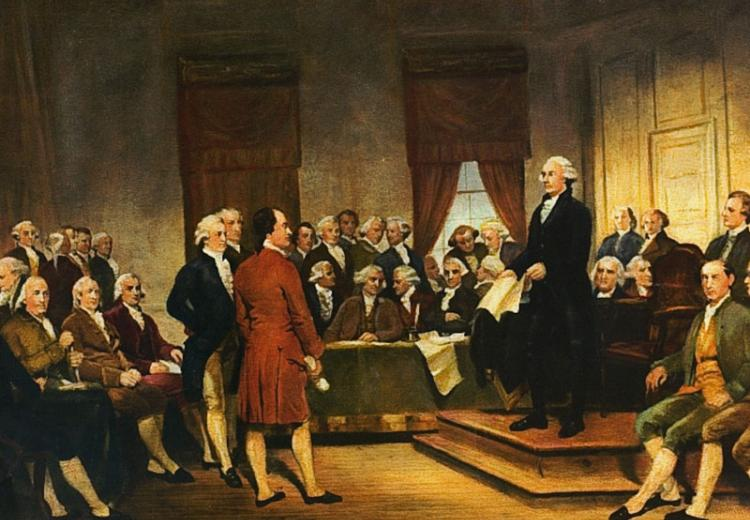In September 1787, after four months of intense and secretive discussions, the United States Constitution was finally unveiled. And what happened next? Absolute chaos. The debate over whether to accept or reject the new Constitution ignited a nationwide shouting match that made the original Constitutional Convention look like a polite dinner party. This wasn’t just any political squabble—this was the first time in human history that people were attempting to create a nation entirely through deliberation, without divine right, monarchy, or coercion. No kings, no gods, just men arguing about the best way to build a country from scratch.

The Battle Lines Are Drawn
The debate split the nation into two factions: the Federalists, who supported the new Constitution, and the Anti-Federalists, who feared it would create a centralized government too powerful for comfort. The Anti-Federalists were led by some of the most radical revolutionaries—Samuel Adams of Massachusetts and Patrick Henry of Virginia, the same firebrands who had fanned the flames of independence. To them, freedom was the whole point of the revolution, and the Constitution seemed like a step backward. Patrick Henry even famously declared, “I smell a rat,” believing that the new government would just be a rebranded version of British tyranny.
On the Federalist side, James Madison, Alexander Hamilton, and John Jay feverishly wrote essays that became the Federalist Papers, arguing for the necessity of a strong central government. Meanwhile, Madison maneuvered politically, convincing Congress to send the Constitution to the states for debate rather than outright rejecting it. His strategy? If Congress stayed silent, no one could claim the Constitution was illegal. Silence, in this case, was golden.
The Virginia Showdown
Virginia was the key battleground. If Virginia, the most populous and influential state, rejected the Constitution, it could spell disaster for the fledgling nation. But the situation was dire—Anti-Federalist sentiment was strong, and leading the charge against the Constitution was none other than Patrick Henry, a man whose speeches could make even his opponents’ hair stand on end. Thomas Jefferson once said that listening to Henry speak was electrifying, even if you didn’t agree with him.
Henry’s argument was simple but powerful: the Constitution replaced “We the States” with “We the People.” To him, that was code for centralized power and the erosion of state rights. He painted a picture of a creeping authoritarianism, where the new government would trample the hard-won liberties of the American Revolution.
On the other side was James Madison, a brilliant thinker but not exactly an orator. His voice was so weak that often, the official notes of the debate simply recorded: “inaudible.” But Madison had a secret weapon—Virginia Governor Edmund Randolph. Originally an opponent of the Constitution, Randolph switched sides after relentless persuasion by Madison and George Washington. With his political pedigree and natural charisma, Randolph gave the Federalists the boost they needed.
The Tipping Point
As the Virginia Convention dragged on, the momentum slowly shifted. By June 1788, nine states had ratified the Constitution—just one more was needed to make it law. Virginia’s decision would determine the future of the United States.
After weeks of fiery debates, the final vote was shockingly close: 89 in favor, 79 against. The Constitution was officially ratified, but the opposition wasn’t silenced. To appease Anti-Federalists, Madison promised to add a Bill of Rights—ten amendments that would explicitly protect individual liberties, ensuring that government power would always have limits.
Why It Still Matters
The fight over the Constitution wasn’t just about governance; it was about the soul of America. The same tensions—state vs. federal power, individual freedom vs. government authority—continue to shape political debates today. Even the structure of the Senate, which gives smaller states disproportionate power, remains a point of contention.
The takeaway? America’s foundation wasn’t set in stone—it was built on debate, disagreement, and compromise. And just like in 1787, the argument over what kind of nation the United States should be is far from over.

No comments yet.